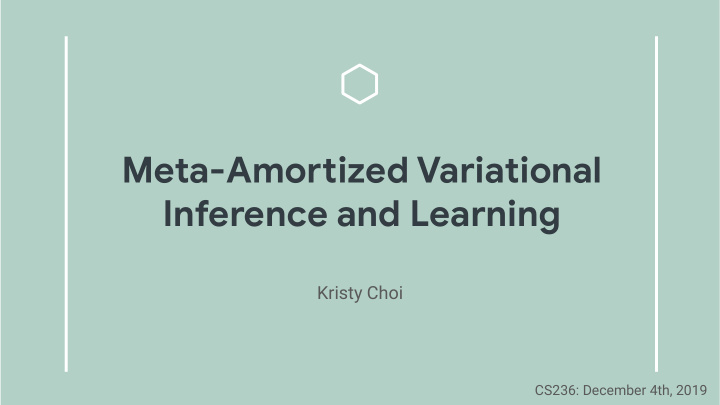



Meta-Amoruized Variational Inference and Learning Kristy Choi CS236: December 4th, 2019
Probabilistic Inference Probabilistic inference is a paruicular way of viewing the world: + = Observations Updated (posterior) Prior belief Typically the beliefs are “hidden” (unobserved), and we want to belief model them using latent variables.
Probabilistic Inference Many machine learning applications can be cast as probabilistic inference queries: Medical diagnosis Bioinformatics Human cognition Computer vision
Medical Diagnosis Example observed symptoms z identity of disease x N Goal: Infer identity of disease given a set of observed symptoms from a patient population.
Exact Inference intractable integral disease z family of tractable distributions x symptoms N Marginal is intractable, we can’t compute this even if we want to
Approximate Variational Inference dependence on x : learn new q per data point disease z → turned an intractable inference problem into an x optimization problem symptoms N
Amoruized Variational Inference deterministic mapping predicts z as a function of x disease z → scalability: VAE formulation x symptoms N
Multiple Patient Populations disease disease disease disease disease z z z z z Doctor is equivalently re-learning how to diagnose an illness :/ x x x x x N N N N N symptoms symptoms symptoms symptoms symptoms
Multiple Patient Populations Share statistical strength across difgerent populations to infer latent representations that transfer to similar, but previously unseen populations (distributions)
(Naive) Meta-Amoruized Variational Inference meta-distribution
Meta-Amoruized Variational Inference shared meta-inference network meta-distribution
Meta-Inference Network ● Meta-inference model takes in 2 inputs: Marginal ○ Query point ○ ● Mapping ● Parameterize encoder with neural network ● Dataset : represent each marginal distribution as a set of samples
In Practice: MetaVAE aggregation network samples query summary network decoder_i Summary network ingests samples from each dataset Aggregation network pergorms inference
Related Work Neural Statistician Variational Homoencoder (VHE) VAE MetaVAE c c z z x D x D x z z D D D x D T x N T x != x T D T x T x T T x D = x T T x D ! = x T Avoid restrictive assumption on global prior over datasets p(c)
Intuition: Clustering Mixtures of Gaussians z = 1 z = 0 Learns how to cluster : for 50 datasets, MetaVAE achieves 9.9% clustering error, while VAE gets 27.9%
Learning Invariant Representations Apply various ● transformations Amoruize over subsets ● of transformations, learn representations Test representations ● on held-out transformations (classifjcation)
Invariance Experiment Results MetaVAE representations consistently outpergorm NS/VHE on MNIST + NORB datasets
Analysis MetaVAE representations tend not to change very much within a family of transformations that it was amoruized over, as desired.
Conclusion Limitations ● No sampling ○ Semi-parametric ○ Arbitrary dataset construction ○ Developed an algorithm for a family of probabilistic models: ● meta-amoruized inference paradigm MetaVAE learns transferrable representations that generalize ● well across similar data distributions in downstream tasks Paper: htups://arxiv.org/pdf/1902.01950.pdf ●
Encoding Musical Style with Transformer Autoencoders
Generative Models for Music Generating music is a challenging problem, as music ● contains structure at multiple timescales. Periodicity, repetition ○ Coherence in style and rhythm across (long) time periods! ● raw audio: WaveNet, symbolic: RNNs, GANs, etc. LSTMs, etc.
Music Transformer ● Symbolic: event-based representation that allows for generation of expressive pergormances (without generating a score) ● Current SOTA in music generation Can generate music over 60 seconds in length ○ ● Atuention-based Replaces self-atuention with relative atuention ○
What We Want Control music generation using either (1) pergormance or (2) ● melody + perg as conditioning Generate pieces that sound similar in style to input pieces! ●
Transformer Autoencoder 1. Sum 2. Concatenation 3. Tile (temporal dimension)
Quantitative Metrics Transformer autoencoder (both pergormance-only and melody & perg) outpergorm baselines in generating similar pieces!
Samples Twinkle, Twinkle melody Claire de Lune Conditioning Pergormance Conditioning Pergormance Generated Pergormance: Generated Pergormance: “Twinkle, Twinkle” in the style “Claire de Lune” in the style of the above pergormance of the above pergormance
Conclusion ● Developed a method for controllable generation with high-level controls for music Demonstrated effjcacy both quantitatively and ○ through qualitative listening tests ● Thanks! Stanford: Mike Wu, Noah Goodman, Stefano Ermon ○ Magenta @ Google Brain: Jesse Engel, Ian Simon, ○ Curuis “Fjord” Hawthorne, Monica Dinculescu
References 1. Edwards, H., and Storkey, A. Towards a neural statistician. 2016 2. Hewitu, L. B., Nye, M. I.; Gane, A.; Jaakkola, T., and Tenenbaum, J.B. Variational Homoencoder. 2018 3. Kingma, D.P., and Welling, M. Auto-encoding variational bayes. 2013 4. Gershman, S., and Goodman, N. Amoruized inference in probabilistic reasoning. 2014 5. Jordan, M. I.; Ghahramani, Z.; Jaakkola, T.S.; and Saul, L.K. An introduction to variational methods for graphical models. 1999 6. Blei, D. M.; Kuckelbir, A.; and McAulifge, J.D. Variational inference: a review for statisticians. 2017 7. Huang, C.Z.; Vaswani, A., Uskoreit, J., Shazeer, N., Simon, I., Hawthorne, C., Dai, A. M., Hofgman, M. D., Dinculescu, M., Eck, D. Music Transformer. 2019 8. Vaswani, A., Shazeer, N., Parmar, N., Uszkoreit, J., Jones, L., Gomez, A. N., Kaiser, L., Polosukhin, I. Atuention is all you need. 2017 9. Shaw, P., Uszkoreit, J., Vaswani, A. Self-Atuention with relative position representations. 2018 10. htups://magenta.tensorglow.org/music-transformer 11. Engel, J., Agrawal, K. K., Chen, S., Gulrajani, I., Donahue, C., Roberus, A. Adversarial Neural Audio Synthesis. 2019 12. Van den Oord, A., Dieleman, S., Zen, H., Simonyan, K., Vinyals, O., Graves, A., Kalchbrenner, N., Senior, A., Kavukcuoglu, K. WaveNet: A Generative Model for Raw Audio. 2016 13. Kalchbrenner, N., Elsen, E., Simonyan, K., Noury, S., Casagrande, N., Lockharu, E., Stimberg, F., van den Oord, A., Dieleman, S., Kavukcuoglu, K. Effjcient Neural Audio Synthesis. 2018
Recommend
More recommend